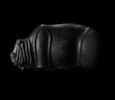The 'Guennol' Rhinoceros
The 'Guennol' Rhinoceros
Roman, possibly Egypt.
Hadrianic Period, 76-138 A.D.
Black Marble
L: 26cm
Sold
An extraordinarily fine carving of a male Indian rhinoceros in dense black marble. It is fragmentary, broken off at the muzzle and at the top of the legs. The ears are gone and only the proper left eye is preserved, deeply incised and staring. Any evidence of a horn has been lost with the asymmetric break of the snout. The carving emphasises the large volumes of the mammal with a gentle nuchal hump above the lowered short neck. The heavy flesh is gathered into four distinctive and pronounced concentric rings of folds articulating the compressed neck (three behind the stumps of the ears and one in front) that is dropped from the shoulder. Sharp vertical flesh folds delineate the contours of the fore and rear legs from the top of the shoulders and rump. These meet another horizontal skirting flesh fold along the base of the body.
The sculptor has focused their efforts on the telling contours and gently swelling volumes, with only a formal stylistic approach to the heavy ‘draping’ of the flesh that distinguishes the animal as a rhinoceros. These flesh folds give the figure an armoured appearance, distinctive for the Indian rhinoceros. An incised groove runs along the spine, from the nuchal hump to just short of the rump. Here one would expect instead a spinal ridge under the heavy flesh. Birds are often seen to perch here in the wild. Perhaps it is the slightly formalist sculptural approach that has allowed this incised sculptural license.
‘Pagan and Christian Egypt from the First to the Tenth Century A.D.’, January-March 1941, Brooklyn Museum, New York.
Brooklyn Museum since 1951.
‘The Guennol Collection’, The Metropolitan Museum of Art, New York, 1969-1970. Loan Number: SL.69.82.39.
The Notable Art Collection Belonging to the Estate of the Late Joseph Brummer Part I, Parke-Bernet Galleries Inc., New York, April 20, 21, 22 & 23, 1949, Lot 33.
The Guennol Collection of Mr & Mrs Alastair B. Martin, Exhibition Catalogue, Metropolitan Museum, 6th November 1969 – 4th January 1970, No. 49.
The Guennol Collection, Volume I, The Metropolitan Museum of Art, 1975, pp. 41-45.
David Aaron Ltd, 2023, No. 11.
Reputedly in the Private Collection of Mr Bernard d’Hendecourt, 7 Rue Bayard, Paris, prior to 15th December 1928.
With M. and R. Stora, Paris and New York, from at least 1936.
Private Collection of Joseph Brummer (1883-1947), acquired from the above 8th December 1936 (inventory number N4014).
Sold at: The Notable Art Collection Belonging to the Estate of the Late Joseph Brummer Part I, Parke-Bernet Galleries Inc, New York, April 20, 21, 22 & 23, 1949, Lot 33.
The ‘Guennol’ Collection, from 1949
With The Merrin Gallery, New York.
Private Collection of Sheikh Saud bin Muhammed Al Thani (1966-2014), acquired from the above 23rd April 2009.
Thence by descent.
ALR: S00156336, with IADAA certificate, this item has been searched against the Interpol database.
Hungarian-born art dealer Joseph Brummer (1883-1947) was born in Sombor, and cultivated an interest in the arts from an early age. He studied art, and was a sculptor all his life, but it is as a connoisseur and art dealer that he is best remembered.
He moved to Paris and formed a partnership with the Maison Delhomme to sell antiquities at 67 Boulevard Raspail in Paris. In November of 1910, he set up his own gallery, Maison Joseph Brummer, at the same address, and a couple of months later moved to yet another location and renamed the gallery Brummer: Objets d’art anciens. His younger brothers Imre (1889–1928) and Ernest (1891–1964), soon joined him and the gallery was renamed Brummer Frères: Curiosités. The brothers worked in Paris for two years, while Ernest studied art history and archaeology at the École du Louvre and the Sorbonne. In 1914, Joseph and Imre would immigrate to New York and open a gallery on 57th Street
The Paris branch closed after the First World War and in 1921 Joseph moved to New York full-time, becoming one of the pre-eminent dealers of his time, specialising in medieval and Renaissance European art, and Classical, Ancient Egyptian, African, and pre-Columbian objects, as well as holding exhibitions of modern painters.
He built up an extraordinary private collection during this time, a major portion of which was bought by the Metropolitan Museum of Art on his death in 1947. The remaining collection was sold in 1949 at Parke-Bernet Galleries.
The Guennol Collection is the celebrated collection of Alastair Bradley Martin and his wife, Edith Park Martin, who named the collection Guennol, the Welsh word for “marten” (a small mammal), as a play on their surname and because they spent part of their honeymoon in Wales.
They began collection after the Second World War, and their passion for objects transcended any one collecting category or time period, featuring outstanding examples of ancient art of many cultures, American Folk Art, African and Asian Art. Works of art were not selected for investment or because of trends in the market; their taste was highly personal and eclectic. Of their collecting, Mr. Martin once wrote, “The fundamental rule is this: If something gives you pleasure, buy it.” Their enthusiasm for collecting was matched only by their generosity.
Beginning in 1948 Mr. Martin became a trustee of the Brooklyn Museum of Art, and for a term served as the Board’s President. It was a long association that included the donation of important objects as well as the loan of dozens of significant works, including The Guennol Lioness. Various treasures from their collection have also been lent for special exhibitions at other institutions such as the Metropolitan Museum of Art, the Fogg Art Museum and the Jewish Museum, among others. The Guennol Collection itself has also been the subject of separate, single collection exhibitions at both the Metropolitan Museum of Art (1969) and the Brooklyn Museum of Art (2000).











 Enquire
Enquire




